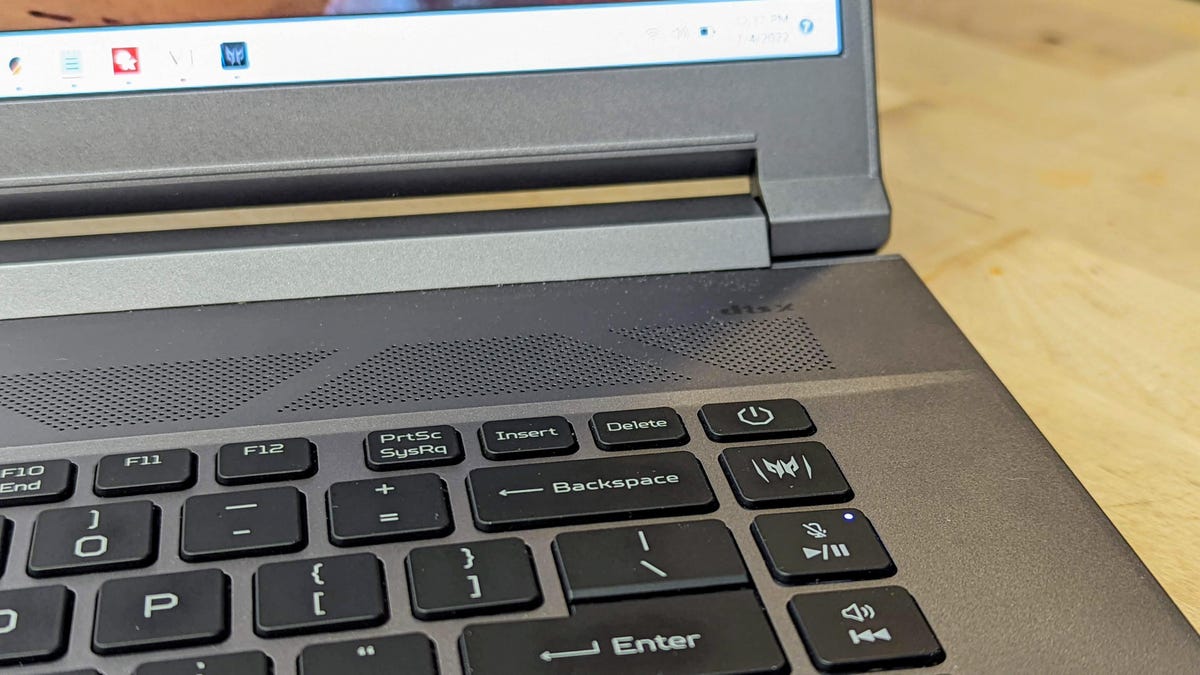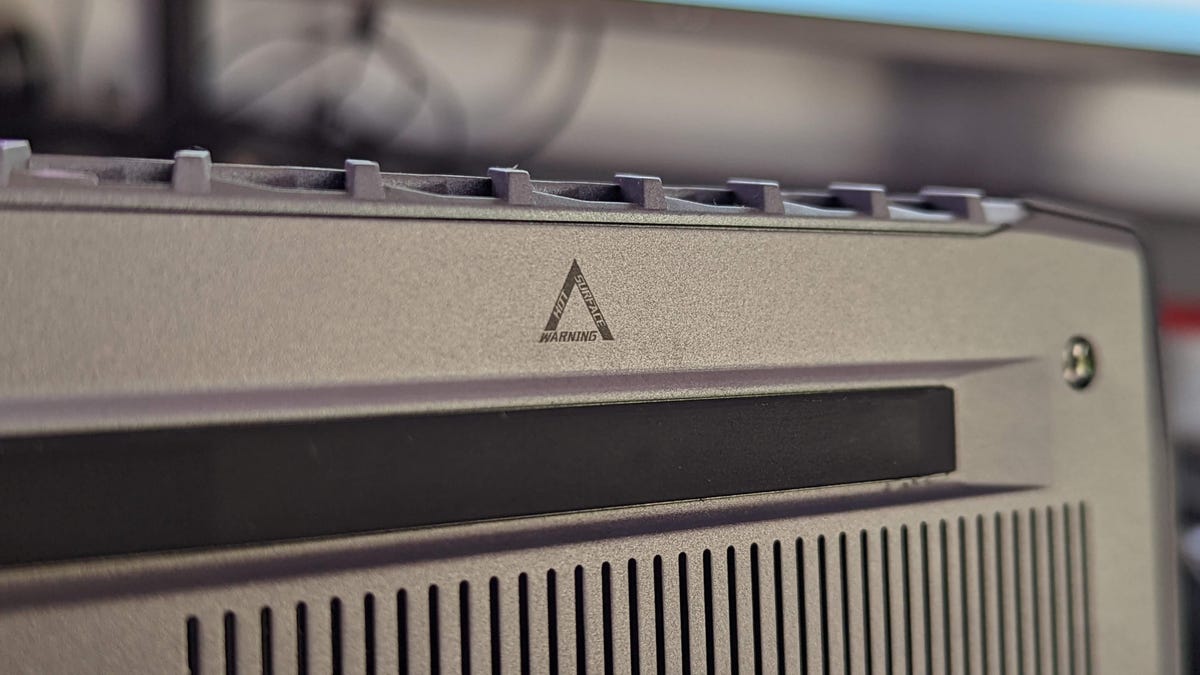The Acer Predator Triton 500 SE is not a budget gaming laptop by any stretch. It starts at $2,100, but the top-end configuration reviewed here is a little under $3,000. While this is cheaper than just about any competitors with its specs, this isn’t an entry-level machine. It’s for a gamer who wants the raw power of a desktop machine with the portability a laptop provides. And, as someone who’s a desktop PC gamer, I’ve been amazed at how well it does in some areas and shocked by how bad it is in others.
While the outside of the 500 SE is rather plain, when you open the lid you are welcomed by a beautiful backlit RGB keyboard. The keys are well-spaced and typing on them is surprisingly nice. I spent a couple of days using it as my work computer and I wasn’t disappointed by the experience. The keys also feel soft and offer great travel, and the keyboard doesn’t feel rubbery as some do after a while. Acer even added dedicated media controls and a PredatorSense button that brings up the overclocking system whenever you need it. And the additions don’t make the keyboard feel cramped, which can often happen when you shoehorn in extra keys.
Acer Predator Triton 500 SE (2022)
| Price as reviewed | $3,000 |
|---|---|
| Display size/resolution | 16-inch 2,560×1,600 display (240Hz) |
| CPU | 5GHz Intel Core i9-12900H |
| Memory | 32GB LPDDR5 SDRAM |
| Graphics | 16GB Nvidia GeForce RTX 3080 Ti graphics |
| Storage | 1TB PCIe NVMe SSD |
| Networking | Killer Wireless Wi-Fi 6E AX1675, Killer Ethernet E3100 10/100/1000, Bluetooth 5.2 |
| Operating system | Microsoft Windows 11 Home |
| Ports | SD 7.0 cardreader, 2 USB 3.2 Gen 2, 2 Thunderbolt 4, HDMI 2.1, DC-in, RJ45, Audio Jack |
One of my biggest bugbears when it comes to gaming laptops over the years is the touchpad. While the 500 SE has a glass-topped touchpad that feels smooth under your hands, the functionality is just not there. The pad itself works fine if you tap the top, but pressing it feels cheap and awkward. It pushes down too far and often doesn’t register the click when I do press it. In the end, I stopped using it and used my Razer Naga Pro gaming mouse instead. The only positive with the touchpad is the built-in fingerprint reader, which makes it easy to log in to your laptop securely using Windows Hello.

The PredatorSense key was helpful while I tracked heat buildup.
James Bricknell/CNET
The display is something of a joy, though. The 2,560×1,600-resolution display is 16:10 rather than 16:9, which I appreciate. I know it isn’t a massive difference, but the taller screen lets it fit in the bottom bar without sacrificing gaming real estate, so it’s a welcome shift. Visuals are crisp and clean, as you would expect from a 240Hz panel with a max brightness of 500 nits. I found the brightness on this screen held up in most lighting conditions short of direct sunlight.
When it comes to gaming performance, the Triton 500 SE is pretty much the cream of the crop in this price range. It’s worth mentioning that the 500 SE has more memory and a better processor than the rest of the machines tested in our benchmarks, but the cost is equal to or lower than other offerings in this space. For example, we recently reviewed the Razer Blade 15, and while it’s more expensive it failed to beat the 500 SE in any of our tests. This makes the 500 SE something of a bargain for a high-end gaming laptop, even at $3,000. (The 2022 Triton 500 SE isn’t currently available in the UK or Australia, but the price of my review laptop converts to roughly £2,525 or AU$4,450.)
All of the games I played, from first-person shooters like Counter-Strike: Global Offensive and Destiny 2 to strategy games like Civilization 6, worked beautifully. Graphically they looked fantastic of course — with an Nvidia RTX 3080 Ti graphics card you would expect nothing less — but even on high or ultra settings I experienced no lag or slowdown, even when the screen was filled with enemies and particle effects. Clearly, the 500 SE was born to play games and it does it with the ease and skill you would expect from a powerhouse like this.

Playing Sea of Thieves as rendered by the 3080 GPU was a pleasure.
James Bricknell/CNET
Playing games on battery power is a different experience, though. As you can see from our battery drain test, the 500 SE isn’t the best or worst, though the battery will drain much faster when gaming. That’s normal and I managed to get around 1 hour, 10 minutes, before the battery dropped to 10% and I was forced to plug it back in. The Acer uses MUX switching technology to swap between the power-hungry RTX 3080 GPU and the more energy-efficient integrated graphics. It works great if you’re not looking to play graphics-intensive games on battery power, but the moment you switch to using only the 3080 your gaming minutes are numbered.

These numbers are a little too high to want to keep this sitting in my lap.
James Bricknell/CNET
Whether you’ve got it on battery or running off its power brick, one thing is certain: The 500 SE has a heating problem. While Acer speaks of its “fifth-generation AeroBlade 3D fans” and “liquid metal thermal grease” I’ve never used a laptop that runs this hot. After three hours of playing Civilization 6, the system temperature reached 82 Celsius or a whopping 180 degrees Fahrenheit — enough to make a decent cup of green tea.
The entire laptop got so hot that using the touchpad made my wrist uncomfortable to the point of pain. I dread to think what it would be like with the lid closed and attached to a monitor. If you’re going to play games on this for long sessions you will want to keep it on a desk and as cool as possible. Certainly don’t play for long sessions with the laptop in your actual lap. That will get uncomfortable very quickly.

A warning label is never a good sign.
James Bricknell/CNET
Heating issues aside, I’ve really enjoyed my time with the Acer Predator Triton 500 SE gaming laptop (though I think that name is ridiculous). If I’m going to spend $3,000 on a laptop I want it to run anything I can throw at it with equal ease and the 500 SE can do just that. In addition to gaming, I used the laptop for photo editing and rendering 3D models that I’ve designed and it easily handled both tasks, often simultaneously, something that even my custom-designed PC struggles to do.
Gaming on the 500 SE was an excellent experience (apart from the excessive heat and the touchpad, of course). I was pleasantly surprised by how crisp the screen was, and even when I hooked it up to my old 70Hz monitor everything ran smooth as butter. While the battery life is pretty poor when using the discrete graphics card, having the option to switch between it and the onboard graphics on the fly is a huge bonus. It means you can use your laptop for browsing and streaming and get relatively good battery life, then plug it in when you’re ready for a big gaming session. Just keep it on the table or you might burn your biscuits.
Geekbench 5 (multicore)
Acer Predator Triton 500 SE (2022)
Dell Inspiron 16 Plus (7610)
Note:
Longer bars indicate better performance
Cinebench R20 CPU (multicore)
Acer Predator Triton 500 SE (2022)
Dell Inspiron 16 Plus (7610)
Note:
Longer bars indicate better performance
PCMark 10 Pro Edition
Acer Predator Triton 500 SE (2022)
Dell Inspiron 16 Plus (7610)
Note:
Longer bars indicate better performance
Streaming video playback battery drain test (minutes)
Dell Inspiron 16 Plus (7610)
Acer Predator Triton 500 SE (2022)
Note:
Longer bars indicate better performance
System configurations
| Razer Blade 15 (2022) | Microsoft Windows 11 Home; 2.4GHz Intel Core i7-12800H; 16GB DDR5 4,800MH; 8GB Nvidia GeForce RTX 3070Ti; 1TB SSD | |
|---|---|---|
| HP Victus 16 | Microsoft Windows 11 Home; 2.3GHz Intel Core i7-11800H; 16GB DDR4 3,200MHz; 6GB Nvidia GeForce RTX 3060; 512GB SSD | |
| Dell Inspiron 16 Plus (7610) | Microsoft Windows 11 Home; 2.3GHz Intel Core i7-11800H; 16GB DDR4 3,200MHz; 4GB Nvidia GeForce RTX 3050; 512GB SSD | |
| Acer Predator Triton 500 SE (2022) | Microsoft Windows 11 Home; 2.9GHz Intel Core i9-12900H; 32GB DDR5 4,800MHz; 16GB Nvidia Geforce RTX 3080Ti; 1TB SSD | |
| Acer Nitro 5 AN515-58 | Microsoft Windows 11 Home; 2.5GHz Intel Core i5-12500H; 16GB DDR4 3,200MHz; 6GB Nvidia GeForce RTX 3060; 512GB SSD |




